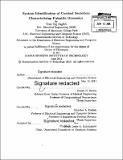System identification of cortisol secretion : characterizing pulsatile dynamics
Author(s)
Faghih, Rose Taj
DownloadFull printable version (7.708Mb)
Other Contributors
Massachusetts Institute of Technology. Department of Electrical Engineering and Computer Science.
Advisor
Emery N. Brown and Munther A. Dahleh.
Terms of use
Metadata
Show full item recordAbstract
Cortisol controls the body's metabolism and response to inflammation and stress. Cortisol is released in pulses from the adrenal glands in response to pulses of adreno-corticotropic hormone (ACTH) released from the anterior pituitary; in return, cortisol has a negative feedback effect on ACTH release. Modeling cortisol secretion and the interactions between ACTH and cortisol allows for quantifying normal and abnormal physiology and can potentially be used for diagnosis and optimal treatment of some cortisol disorders. Due to noise, modeling these interactions using concurrent data from serum ACTH and cortisol levels is challenging. First, using serum cortisol levels, we model cortisol secretion from the adrenal glands by representing the sparse pulses of cortisol using an impulse train. We formulate an optimization problem and successfully recover infusion and clearance rates as well as physiologically plausible cortisol pulses. Then, for serum ACTH and cortisol levels, we model ACTH and cortisol secretion by representing the sparse ACTH pulses using an impulse train. By considering a multi-rate system, we formulate another optimization problem and successfully recover model parameters as well as physiologically plausible ACTH pulses. We solve both optimization problems under the assumption that the number of pulses is between 15 to 22 pulses over 24 hours, and recover the timing and amplitudes of the pulses using compressed sensing, and employ generalized cross validation for determining the number of pulses. In all our studies mentioned above, the datasets we use consist of ACTH and cortisol levels sampled at 10-minute intervals from 10 healthy women. Finally, we present a mathematical characterization of pulsatile cortisol secretion. We hypothesize that there is a controller in the anterior pituitary that leads to pulsatile release of cortisol, and propose a mathematical formulation for such controller. Our proposed controller achieves impulse control, and the obtained impulses and plasma cortisol levels exhibit cortisol circadian and ultradian rhythms that are in agreement with experimental data.
Description
Thesis: Ph. D., Massachusetts Institute of Technology, Department of Electrical Engineering and Computer Science, 2014. Cataloged from PDF version of thesis. Includes bibliographical references (pages 108-113).
Date issued
2014Department
Massachusetts Institute of Technology. Department of Electrical Engineering and Computer SciencePublisher
Massachusetts Institute of Technology
Keywords
Electrical Engineering and Computer Science.